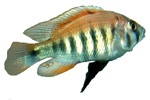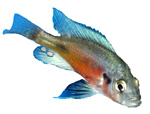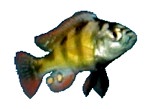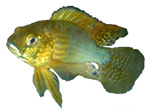
Eretmodus - A Lake Tanganyikan Oddity. This is one of the Goby Cichlids, very similar in behavior to saltwater Hawkfishes. They are monogamous Bi-Parental mouthbrooders. The female broods the eggs, and after approximately 10 days, the fry are transferred to the males mouth who then broods them for approximately another 10 days. Eretmodus are herbivores. They can be extremely aggressive, primarily with each other, although they can also be problematic with other fish. A single fish can be kept in tanks as small as 20 gallons, but if they are going to be housed in numbers, 55 gallons and up is ideal.
| Exochochromis - anagenys is currently the only species available. As they mature, females and males are both yellow with three black spots. However, when spawning the males turn deep purple. This Malawian fish appears to be a predator. Exochochromis get large, requiring a minimum of 75 gallons. Exochochromis are extremely sensitive mothers, which will spit a brood at the first disturbance. |

Exochochromis anagenys
(Female) |
| Fossorochromis - Very active fish from Lake Malawi. They should be kept in a large tank, at least 75 gallons. They are polygamous mouthbrooders. (Formerly Haplochromis) |

Fossorochromis rostratus |
|
Haplochromis (Victorian) - This genus
used to include "Haplochromine" fishes from Lake
Malawi which are now reclassified into 23 genera such as
Copadichromis, Protomelas, Nimbochromis, Sciaenochromis,
Otopharynx. The fish remaining in the genus Haplochromis
may also be assigned to Astatotilapia depending
on the author. These Haplochromis are all (with few
exceptions) native to Lake Victoria and the surrounding
satellite lakes.
All are polygamous mouthbrooders. Diet wise, some of these
fish are very specialized feeders, but most do fine on an
omnivorous diet. Spirulina flakes usually help bring out
their color and satisfy their need for vegetable matter.
With a few exceptions, only the males have brilliant color,
and in some species, it is only displayed during courting.
These fish also lose their coloration easily when stressed.
Despite all these "drawbacks", they can be some of the most
colorful Cichlids available. Proper care, diet, conditions,
and a little patience make these fish very rewarding. There
are a few dwarf species which could be kept in tanks as
small as 20 gallons, although they are rarely available.
Most species are better off 30+, preferably 45 and up. They
can be very aggressive, but usually most of their display
is bluff.
Among the Umbrella Genus Haplochromis, there are
several sub-genera or genera which could be elevated to
full Genus Stature. Some of them are listed below, along
with any special characteristics or requirements:
- Astatoreochromis - an extremely generalized
genus.
- Astatotilapia - usually insectivores
- Harpagochromis - piscivores (fish-eating
predators), usually larger fish 6"+
- Neochromis - algae scrapers, feed spirulina,
more territorial
- Paralabidochromis - generally micro-predatory/omnivorous
- Ptyochromis - generally snail eaters
- Pundamilia - a new genus encompassing
the "nyererei types" - most are micro-predators
- Pyxichromis - piscivores, larger than
6" as adults
- Xystichromis - unspecialized, generally
omnivorous, sometimes smaller
|

Haplochromis sp.
"Ruby Green"
|

Haplochromis sp.
"Fire" (True)
|

Pundamilia nyererei
|

Pundamilia nyererei
"Ruti Island"
|

Pundamilia sp.
"Crimson Tide" TRUE
(Red Snout)
|
|

Pundamilia sp.
"Zebra Nyererei"
|

Haplochromis sp.
"Kenya Gold"
|

Haplochromis sp.
"Fire Red Ugandan"
(Young Male, not full Color!)
|

Pundamilia cf.
"Crimson Tide"
|

Astatotilapia aneocolor
"Largemouth Lake Edward"
|

Haplochromis sp.
"Hippo Pointe Salmon"
|

Haplochromis sp.
"Dayglow"
|

Pyxichromis orthostoma
"Largemouth"
(Female)
|

Haplochromis ishmaeli
|

Astatotilapia latifasciata
"Zebra Obliquidens"
|

Astatotilapia latifasciata
"Albino Zebra Obliquidens"
(Developed by The Cichlid Factory; NOT a cross!)
|

Paralabidochromis chromogymnos
"Zue Island"
|

Haplochromis sp.
"Flameback"
|

Paralabidochromis sp.
"Ugandan Red Side
|

Astatotilapia aneocolor
"Lake Victoria"
(A Young Male)
|

Astatotilapia aneocolor
"Yellow Belly Lake Albert"
|

Astatoreochromis
alluaudi
|

Haplochromis obliquidens
|

Paralabidochromis chilotes
"Kenya Blue"
|

Harpagochromis sp.
"Golden Duck"
|

Paralabidochromis sp.
"Albino Half Crimson"
|

Paralabidochromis sp.
"Mbita Gold Chest"
|
|